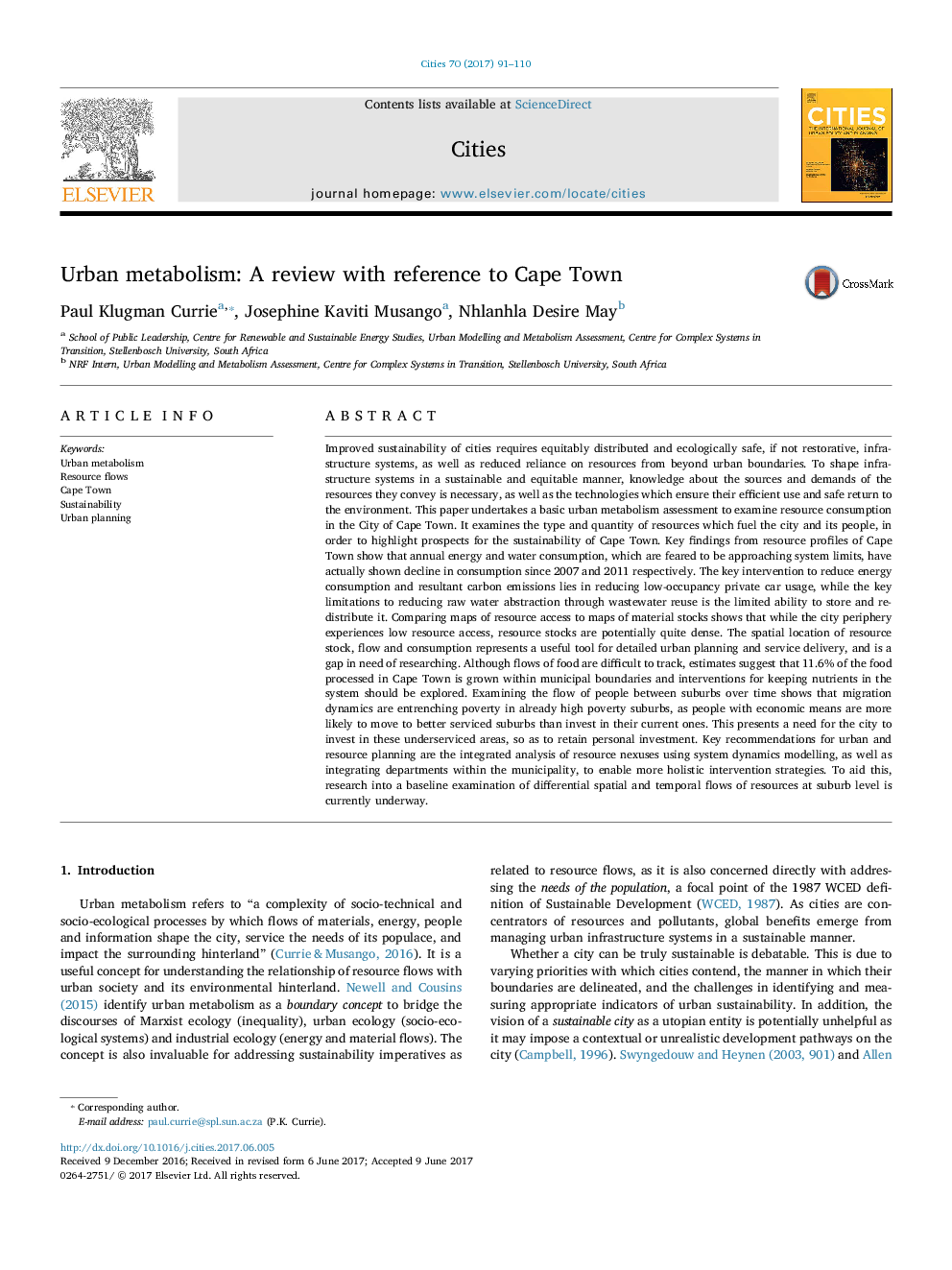ترجمه فارسی عنوان مقاله
متابولیسم شهری: بررسی با اشاره به کیپ تاون
عنوان انگلیسی
Urban metabolism: A review with reference to Cape Town
| کد مقاله | سال انتشار | تعداد صفحات مقاله انگلیسی |
|---|---|---|
| 162008 | 2017 | 20 صفحه PDF |
منبع

Publisher : Elsevier - Science Direct (الزویر - ساینس دایرکت)
Journal : Cities, Volume 70, October 2017, Pages 91-110
ترجمه کلمات کلیدی
متابولیسم شهری، جریان منابع، کیپ تاون، پایداری، برنامه ریزی شهری،
کلمات کلیدی انگلیسی
Urban metabolism; Resource flows; Cape Town; Sustainability; Urban planning;
ترجمه چکیده
بهبود پایداری شهرها نیازمند سیستم های زیربنایی و محیط زیست ایمن و غیرقابل برگشت، و نیز کاهش وابستگی به منابع از مرزهای شهری است. برای شکل دادن به سیستم های زیربنایی به شیوه ای پایدار و عادلانه، دانش در مورد منابع و نیازهای منابع مورد نیاز آنها، و نیز فن آوری هایی که از کارایی کارآمد آنها و بازگشت امن به محیط اطمینان حاصل می شود، ضروری است. این مقاله، ارزیابی متابولیسم شهری را برای بررسی مصرف منابع در شهر کیپ تاون انجام می دهد. این نوع و کمیت منابع مورد بررسی را بررسی می کند که شهر و مردم آن را تامین می کند تا بتواند چشم انداز پایداری کیپ تاون را برجسته سازد. یافته های کلیدی از پروفایل منابع کیپ تاون نشان می دهد که مصرف سالیانه انرژی و آب، که از تهدید به نزدیک شدن به محدودیت های سیستم می باشد، در مقایسه با سال های 2007 و 2011، کاهش مصرف داشته است. مداخلات کلیدی برای کاهش مصرف انرژی و انتشار گازهای گلخانهای ناشی از آن، کاهش مصرف ماشینهای خصوصی با استفاده از اشغال کم است، در حالی که محدودیت های کلیدی برای کاهش آب انتزاعی خورشید از طریق استفاده مجدد از فاضلاب محدود کردن توانایی ذخیره و توزیع آن است. مقایسه نقشه دسترسی منابع به نقشه های سهام مواد نشان می دهد که در حالی که محیط اطراف شهر دسترسی کم منابع را تجربه می کند، منابع به طور بالقوه بسیار متراکم هستند. مکان فضایی سهام منابع، جریان و مصرف یک ابزار مفید برای برنامه ریزی دقیق شهری و ارائه خدمات است و شکاف نیاز به تحقیق است. گرچه جریانهای غذا برای ردیابی دشوار است، برآوردها نشان می دهد که 11.6 درصد مواد غذایی که در کیپ تاون پردازش شده اند در داخل مرزهای شهری رشد می کنند و مداخلات برای نگهداری مواد مغذی در سیستم باید مورد بررسی قرار گیرد. بررسی جریان مردم بین حومه ها در طول زمان نشان می دهد که دینامیک مهاجرت فقر را در حومه های فقیرنشین در حال افزایش است؛ چرا که افرادی که دارای ابزار اقتصادی هستند بیشتر به حومه های خدماتی بهتر حرکت می کنند تا سرمایه گذاری در حوزه های فعلی خود. این امر ضروری است که شهر برای سرمایه گذاری در این مناطق ناشناخته، به منظور حفظ سرمایه گذاری شخصی. توصیه های کلیدی برای برنامه ریزی شهری و منابع، تجزیه و تحلیل یکپارچه از ارتباطات منابع با استفاده از مدل سازی دینامیکی سیستم و همچنین ادغام ادارات درون شهرداری است تا راهبردهای مداخله ای جامع تر را در اختیار داشته باشند. برای کمک به این، تحقیقات در زمینه بررسی اولیه جریانهای مختلف فضایی و زمانی منابع در سطح حومه در حال انجام است.

